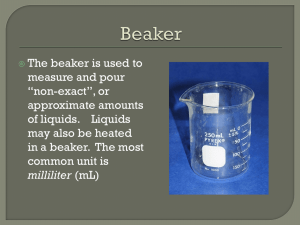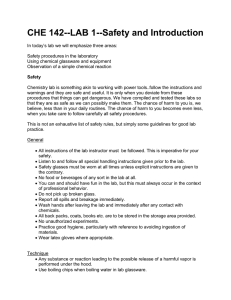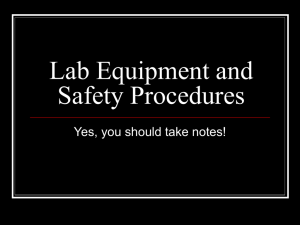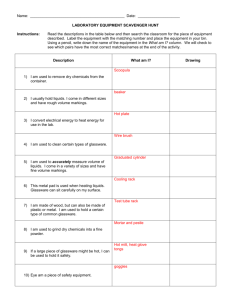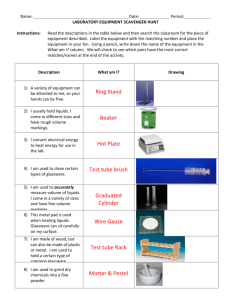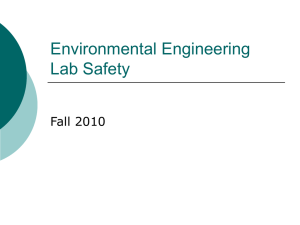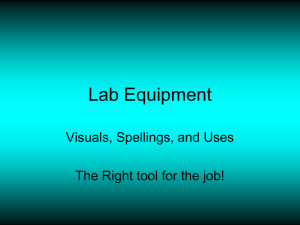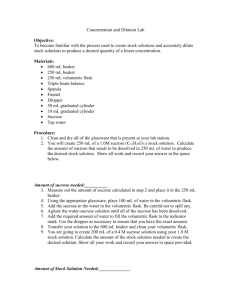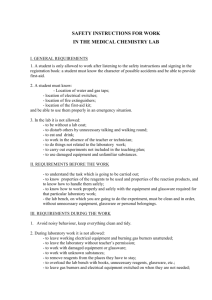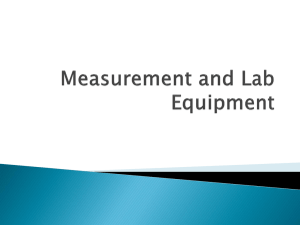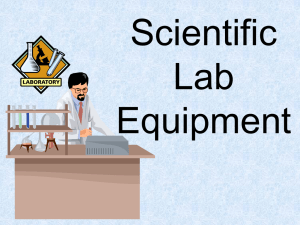Beaker - Midway ISD
advertisement
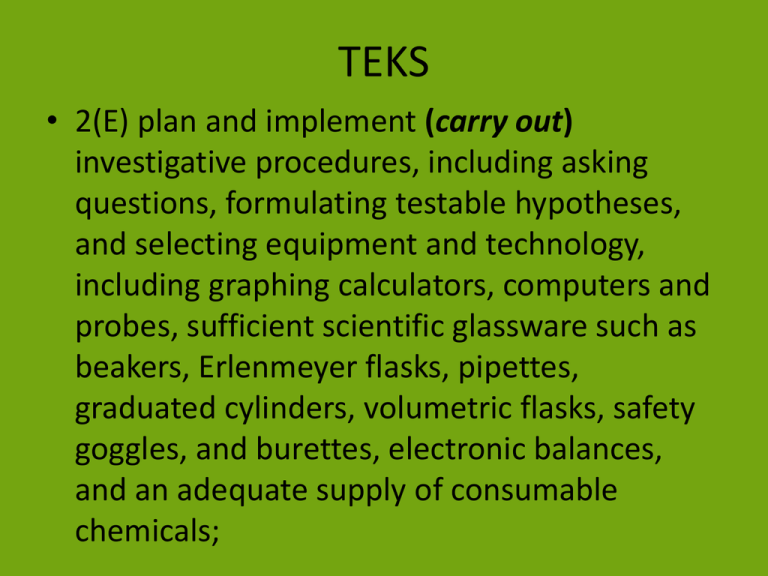
TEKS • 2(E) plan and implement (carry out) investigative procedures, including asking questions, formulating testable hypotheses, and selecting equipment and technology, including graphing calculators, computers and probes, sufficient scientific glassware such as beakers, Erlenmeyer flasks, pipettes, graduated cylinders, volumetric flasks, safety goggles, and burettes, electronic balances, and an adequate supply of consumable chemicals; Wednesday • We will learn how to select glassware for appropriate use in the laboratory • You will: • Be able to identify different types of glassware and predict their possible use in the lab Safety goggles • Used for protecting your eyes in lab. Should be worn especially during labs with chemicals, fire, or glassware involved. Volumetric flasks • . Volumetric flasks are used for precise dilutions and preparation of standard solutions. Beaker • The beaker is used to measure and pour “non-exact”, or approximate amounts of liquids. Liquids may also be heated in a beaker. The most common unit is milliliter (mL) Erlenmyer flask • This container has the same general uses as the beaker. It’s units are also milliliters (mL). Boiling flask • This type of flask is often used when even heating or boiling of a sample is needed. Test tube • Glassware that is used to observe, pour, or heat substances in. There are no measurement markings on test tubes. Dropper • The dropper is used to transfer small amounts of liquid from one container to another; usually one or two drops at a time. No units are used in the transfer of liquids by this method. Test tube rack • A container used to store, set up, or air dry test tubes. Graduated cylinder • An instrument used to measure and pour exact amounts of liquid. The general unit used is milliliter (mL). Test tube clamp • Used to hold test tubes when heating substances over an open flame. Test tube brush • Used to clean the inside of test tubes or other glassware. Ring • An attachment for the ring stand. Used in conjunction with a vertical pole and wire gauze (screen). Wire gauze (wire mesh) • Used in conjunction with the ring stand. It is put on top of the ring, and a beaker or flask is placed on top of it to protect the glassware from the flames. Funnel • The funnel is used to transfer liquids from a large-mouthed container to one with a much smaller opening. There are usually no units associated with the transfer of these liquids. Crucible • A crucible is a container that can withstand very high temperature Wire Triangle with Porcelain Mortar and Pestle Evaporating Dish Used to evaporate excess liquids - to produce a concentrated solution or a solid precipitate Crucible tongs • Tongs used to pick up hot objects or objects that may be contaminated with hazardous substances. Micro Spatula and Spatula/scoopula Watch Glass Triple beam balance • An instrument used to measure the mass of object by moving three different weights on three beams. The unit most associated with mass is the gram (g). Electronic Balance Beaker tongs • Used to pick up or handle beakers when they have been heated. Pipets ( 2 volumetrics,1 graduated) Bunsen Burner Setup Bunsen burner • A piece of equipment used for heating substances with open flame operation. It is fueled with natural gas, supplied through “jets” located at each lab table. Hot plate • An electrical device that is used to heat substances without the danger associated with heating substances with open flames. • It is used to dispense known amounts of a liquid reagent in experiments for which such precision is necessary, such as a titration experiment. Petri dish • The Petri dish is normally filled with a waxy substance called agar. It is used to grow cell cultures by putting it in an incubator to stimulate growth of organisms. Ring stand clamp • Device used to hold equipment or other structures in place on a ring stand. Spring scale • An instrument used to measure the weight of objects by hanging them on a hook at one end of the scale. The unit used is Newtons (N) Stopwatch • Instrument used to measure time intervals. Most common unit is seconds. Meter stick • Used to measure distances. The units used are: meters (m), centimeters (cm), and millimeters (mm). Thermometer • An instrument used to measure the temperature of objects, materials, or substances. The units are degrees Celcius , or degrees Fahrenheit. Striker MSDS • MSDS - Materials Safety Data Sheet Symbols Flammability • Flammability is the ability of a substance to combust 41 Corrosive • A corrosive material is a highly reactive substance that causes damage to living tissue. 42 Radioactivity • Radioactivity refers to the radio active decay of a substance by emitting alpha, beta or gamma particles 43 Biohazard • Biohazard- a biological agent or condition that is a hazard to humans or the environment Proper Disposal and Recycling of Material • Consult the Material Safety Data Sheet (MSDS) before disposing of material • The MSDS for a material gives the material’s chemical name, its composition, date of manufacture, expiration date, storage information, hazard identification, disposal information 46 Quiz
